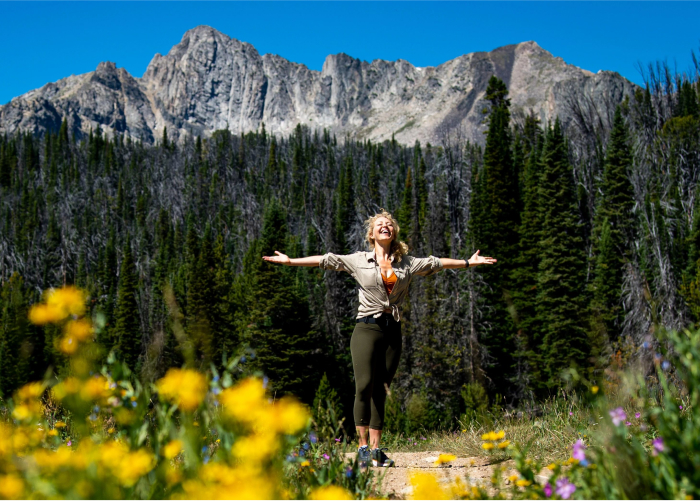
Have you ever spent the day outside or even a few hours and realized after doing so that you feel completely different?
Suddenly you feel recharged and rejuvenated and have more energy than when you started your day.
Getting out in nature benefits your health in a few ways, and scientists have been studying this phenomenon for almost four decades.
We’re diving into that research in this article and the top three benefits of spending time in nature.
We’ll also share how much time you need to be outside to reap these rewards.
3 Benefits of Spending Time in Nature, According to Research
Scientists have been trying to answer whether there are any real benefits of spending time in nature since 1984.
Several studies have come out since then, with over a dozen reported health benefits surfacing as a result.
Here are the top three:
Decreased Stress Levels

One study out of Japan took 280 participants across 24 forests in the region.
Study participants were divided into two groups of six people per location and either visited a forested area or an urban city on the first day and switched places on the second day.
Once at their designated spot, study participants practiced “Shinrin-yoku,” or forest bathing, for 15 minutes before walking around for 15 minutes.
This Japanese practice involves taking in the forest atmosphere through all of your senses while remaining still.
After each session, scientists recorded changes in salivary cortisol levels (a measure of the stress hormone cortisol), blood pressure, and pulse rate in study participants.
At the end of the study, researchers reported a 13.4% drop in salivary cortisol levels, a 6% decrease in pulse rate, and a 1.6% and 1.7% decrease in systolic and diastolic blood pressure, respectively, after people visited and sat in the forested areas.
When participants added the walking element into the forested areas, as compared to doing this in urban areas, they saw a:
- 15.8% drop in salivary cortisol levels
- 3.9% decrease in pulse rate
- 1.9% decrease in systolic blood pressure
- 2.1% decrease in diastolic blood pressure
While these numbers are great to see with just 15 minutes of nature exposure, it’s important to note that the sample size is small, so more research is needed to prove these findings further.
Improved Mental Health

A few studies looked at the mental health benefits of getting outdoors.
The first body of research surveyed 1,000 people living in Southern England, UK, to see how the frequency and time spent in nature could impact mental health.
They found that the more time people spent outdoors in nature, the lower their levels of reported depression were.
Those who spent less time outside reported worsening depression symptoms.
Researchers also discovered that living in an area with more vegetation had the power to reduce the severity of stress, depression, and anxiety people experienced.
Another study in the UK echoed these findings.
Living in a greener area could reduce the odds of experiencing depressive symptoms by up to 4%.
Lastly, a much smaller study involving 18 participants, two of which were healthcare professionals, reported positive perks for people who frequented local wetland areas.
Study participants felt less anxious and experienced fewer negative emotions such as anger, nervousness, or frustration. They also reported feeling happier and that they could relax more once they got out in nature.
The experiment also gave something for people to look forward to, providing the perfect escape from everyday stresses.
Again, since these studies are so small, more research is needed, but the positive results so far are promising.
Better Blood Pressure
Lastly, but just as interesting, a meta-analysis of 20 trials, including 732 study participants, found that being out in nature could reduce systolic and diastolic blood pressure.
For quick reference, systolic blood pressure is the top number in a blood pressure reading (the 120 in a typical 120/80 reading) and it shows the amount of pressure your blood exerts on your artery walls when your heart is beating, according to the American Heart Association.
Diastolic blood pressure, which is the bottom number on a blood pressure reading (the 80 in a normal 120/80 reading), is the amount of pressure your blood exerts on your artery walls between beats and when your heart is resting, as the American Heart Association points out.
Researchers also discovered that these positive blood pressure lowering perks happened when people were forest bathing or walking in it.
So simply getting outside and taking in the sights and sounds of nature is enough to improve health.
After reading about these benefits, you may wonder how this is possible.
How Does Nature Benefit Our Health?

Scientists have proposed two theories that could be at play here:
- Attention restoration theory
- Stress reduction theory
Unsurprisingly, our modern life has zapped our attention and ability to concentrate.
Between endless scrolling on social media and constant emails, text messages, and Slack notifications, it’s even harder to concentrate and stay focused these days.
With attention restoration theory, researchers have hypothesized that being out in nature helps us recharge our mental batteries.
This simple act gives us the energy and ability to focus and direct our attention, and it may help reduce the mental fatigue that so many of us experience.
Stress reduction theory, on the other hand, states that getting outdoors in nature helps turn on our parasympathetic nervous system – the one responsible for our rest and digest cycles that help us relax and properly process the foods we eat, which can help decrease stress along with negative feelings and emotions.
Getting out and connecting to nature can help melt the stresses of your day away and help calm your nerves.
The Sweet Spot to Reap These Health Benefits of Nature

Researchers also found that you don’t need to pack up and move to a forest full-time.
Even short periods out in nature are enough to reap these rewards.
So, how much time in nature do you need to get these perks?
Spending 120 minutes a week in nature, or roughly two hours, is all it takes.
Keep in mind, you don’t have to spend two hours in nature all at once.
You can break this up throughout the week and do ten-minute bursts here or 30-minute spurts there.
However, scientists discovered that getting out in nature less than 120 minutes per week didn’t yield any noticeable results for people.
But once that sweet spot of 120 minutes was achieved, the positive rewards flowed in.
People reported feeling better overall after being out in nature.
Another interesting point is that these benefits peak at 200-300 minutes per week.
So you don’t have to become a full-time forest ranger unless you’re into that.
What to Do If You Can’t Get Outside
You may also reap some of these benefits by looking at nature from indoors.
Scientists found that staring at scenes of nature was enough to decrease stress, fear, and even anger in people, and it also increased feel-good emotions, according to research presented by the University of Minnesota.
A systemic review of 37 articles echoed these findings.
Researchers discovered that looking at videos of natural landscapes, photos, virtual reality, and 3D images was enough to help people relax when stressed.
While the best thing is to get outdoors, you can opt for some indoor relaxation when the weather outside is not so great or you can’t go out.
Another great alternative for those times you can’t physically get out is to work out indoors and use exercise videos that take place in nature.
As you’re walking on a treadmill or using your favorite elliptical, you can stream iFIT workouts, for example, which are filmed all over the world at some of the most incredible outdoor locations.
iFIT, one of the largest fitness libraries, gives you instant access to walking, running, biking, strength, and other workout programs led by expert trainers in just a few taps.
iFIT can be accessed on NordicTrack treadmills, bikes, ellipticals, and rowers or with the iFIT mobile app and iFIT TV app.
The bottom line
While these studies are too small to draw firm conclusions, they’re still great to see.
Getting out in nature is such a simple, low-intervention therapy you could easily give it a try to see how you feel.
You’ll likely find that your body and mind crave being outside in just a few short sessions.
After all, it’s what we as humans were designed to do.
So it’s time to get back to nature and get outdoors.
Trust us, your body and mind will thank you for it.
Disclaimer: This blog post is not intended to replace the advice of a medical professional. The above information should not be used to diagnose, treat, or prevent any disease or medical condition. Please consult your doctor before making any changes to your diet, sleep methods, daily activity, or fitness routine. iFIT assumes no responsibility for any personal injury or damage sustained by any recommendations, opinions, or advice given in this article. Always follow the safety precautions included in the owner’s manual of your fitness equipment.


